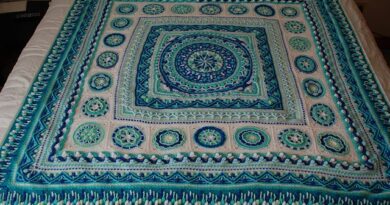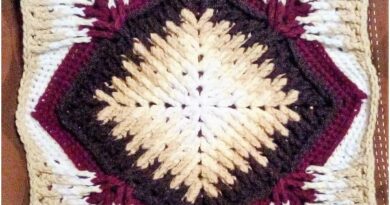Lake Shawl Crochet
The lake shawl is inspired by photos of beautiful sunsets on the great lakes. The dots in the motif create a star shapes and triangles when joined at the corners. The shawl is approximately 170 cm (67 in.) wide and 60 cm (22 in.) high after blocking. The crochet pattern is suitable for all skill levels and is written in UK terms. It is a scarf inspired by the stars and very effective. Shawl is one of the traditional Portuguese costumes. Crochet or crochet (crochet, French) is the process of creating fabrics using the crochet hook and some continuous thread, usually wool, cotton thread, silk etc but you can also use wire, string or other innovative material The origins of the shawl – The first of these shawls came to Europe in the century.
XVIII, from Kashmir, India, “discovered” by travelers (mainly English) who brought them as gifts for wives, mothers and daughters. It is said that in 1796 a blind Persian named Yehyah Sayyid visited Kashmir and the Afghan governor offered him a shawl. Sayyid, in turn, offered it to the Khedive of Egypt, who presented it to Napoleon and gave it to his wife to Empress Josephine de Beauharnais. In France it caused envy and soon elegant women sought by all means to obtain their own Kashmir shawl. Shawls have become the desire of any elegant lady in Europe and America. The rarity, high price and high demand encourages the emergence of imitations in France, Germany and England, produced with goat wool, merina wool, silk and cotton.

Introduction in Portugal – The shawl arrived in Portugal at roughly the same time as in the rest of Europe, it is said that it was also brought by sailors returning from the Orient. Francisco Ribeiro da Silva detected the presence of a shawl among the list of goods confiscated at Alfândega do Porto between 1789 and 1791. Obviously, being a smuggled item means that there is a demand, a market, which is desirable and would be a product only within reach of a privileged few. Through smuggling, the unprivileged rich were able to obtain products that put them on a par with the privileged and, apparently, the shawl would be an excellent outward sign of wealth.
António Morais Silva’s Dictionary (2nd edition of 1813) defines “Chalé, s.m. (from Spanish) – painted scarf with a major brand, which women wear over their shoulders, folded so that it is in three corners, the scarf being square. The English call shawls to a portion of a certain length, and a width of very fine cloth of camello wool, of common yellow, which women draped about their necks, and the ends wound around the body to the waist, and they are expensive assas; come from East India (the Shale).”
The inscription of the word “Chalet” in António Morais Silva’s dictionary means that this garment was already known and used in Portugal in the first quarter of the century. XIX. The shawl in the different regions of Portugal – In Trás-os-Montes and Beiras, the shawl is black, whether Sunday or for daily use. In Alentejo, Ribatejo and Algarve, in addition to black, other colors appear, such as brown or grey, plain or with sober patterns.
The shawl acquires maximum expression in the region of Beira Litoral, especially in the districts of Aveiro and Coimbra, which I consider the “Capital do Xaile”. In this region, the popular taste for the use of the shawl as a complement and adornment to the costume, led to the use of a multiplicity of fabrics of different materials, patterns, prints and unprecedented and unique colors, fostering an industry and a set of arts and crafts closely related to this garment. The shawl is intimately linked to the woman’s figure and her experience.
PATTERN FREE




